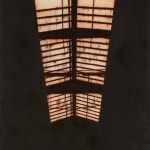
Tony Bevan British, 1951
Skylight (PC1713), 2017
Acrylic and charcoal on canvas
178.5 x 163 cm; (70 1/4 x 64 1/8 in.)
Copyright The Artist
Further images
Skylight (PC1713) (2017) demonstrates Tony Bevan’s ongoing investigation into structure, form, and psychological space. A large-scale canvas rendered in acrylic and charcoal, the piece captures Bevan’s engagement with architectural subjects...
Skylight (PC1713) (2017) demonstrates Tony Bevan’s ongoing investigation into structure, form, and psychological space. A large-scale canvas rendered in acrylic and charcoal, the piece captures Bevan’s engagement with architectural subjects through an expressive yet methodical visual language. This particular work focuses on a skeletal skylight structure, depicted with heavy linearity and a compressed spatial logic that characterises much of Bevan’s exploration of built environments.
Bevan’s approach is rooted in direct observation, yet his rendering is never literal. The source structure is distilled into a scaffold of thick, branching lines – charcoal marks over acrylic pigment – that create a tension between representation and abstraction. In Skylight (PC1713), the skeletal form appears as both architectural diagram and psychological projection, a space that is at once external and internal.
Executed with raw physicality and restraint, the work relies on the materiality of surface and the intensity of mark. As in much of Bevan’s architectural work, the absence of human figures intensifies the sense of containment and introspection.
With Skylight (PC1713), Bevan continues his study of the built world as a proxy for mental and emotional states. The work stands as a meditation on how space is constructed, both physically and psychologically, through structure, repetition, and constraint.
Bevan’s approach is rooted in direct observation, yet his rendering is never literal. The source structure is distilled into a scaffold of thick, branching lines – charcoal marks over acrylic pigment – that create a tension between representation and abstraction. In Skylight (PC1713), the skeletal form appears as both architectural diagram and psychological projection, a space that is at once external and internal.
Executed with raw physicality and restraint, the work relies on the materiality of surface and the intensity of mark. As in much of Bevan’s architectural work, the absence of human figures intensifies the sense of containment and introspection.
With Skylight (PC1713), Bevan continues his study of the built world as a proxy for mental and emotional states. The work stands as a meditation on how space is constructed, both physically and psychologically, through structure, repetition, and constraint.
